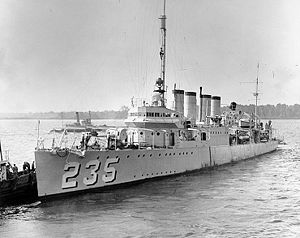USS Kane (DD-235)

| |
| History | |
|---|---|
| Namesake | Elisha Kent Kane |
| Builder | New York Shipbuilding |
| Laid down | 3 July 1918 |
| Launched | 12 August 1919 |
| Commissioned | 11 June 1920 |
| Decommissioned | 31 December 1930 |
| Recommissioned | 1 April 1932 |
| Decommissioned | 28 April 1938 |
| Recommissioned | 23 September 1939 |
| Reclassified | High-speed transport, APD-18, 25 March 1943 |
| Decommissioned | 24 January 1946 |
| Stricken | 25 February 1946 |
| Honors and awards | Seven battle stars for World War II |
| Fate | Sold for scrap 21 June 1946 |
| General characteristics | |
| Class and type | Variant of Clemson-class destroyer |
| Displacement | 1,215 tons |
| Length | 314 feet 5 inches (95.83 m) |
| Beam | 31 feet 8 inches (9.65 m) |
| Draft | 9 feet 4 inches (2.84 m) |
| Propulsion |
|
| Speed | 35 knots (65 km/h) |
| Range | 4,900 nm @ 15 kn (9,100 km @ 28 km/h) |
| Complement | 101 officers and enlisted |
| Armament | 4 x 21 inch (533 mm) tt. |
USS Kane (DD-235/APD-18) was a
Construction and commissioning
Kane was laid down on 3 July 1918 and launched on 12 August 1919 by the New York Shipbuilding Corporation; sponsored by Miss Florence Kane, cousin of Elisha Kent Kane; and commissioned on 11 June 1920.[1]
Service history
Kane departed
On 22 June 1921, Kane rescued an Italian
Kane recommissioned on 1 April 1932, and departed Philadelphia on 29 June for San Diego, her base for the next four years. She got underway from San Diego on 27 April 1936 for
Kane departed New York on 17 August 1936 for Spain to evacuate American citizens whose lives were endangered by the
World War II
Kane recommissioned 23 September 1939 to serve in the
On 11 June, Kane rescued 11 survivors of the torpedoed
Kane departed San Francisco on 24 April and arrived in Cold Bay on 30 April to prepare for the recapture of Attu, Aleutian Islands. The morning of 11 May, Narwhal and Nautilus landed 100 Army scouts northwest of Holtz Bay. Several hours later, Kane was coached in through very dense fog by Pennsylvania's radar to land 400 reconnaissance troops, who then joined the scouts.[1]
During the ground fighting on Attu, Kane served as evacuation hospital transport and shuttled medical supplies between Holtz and
Kane arrived in Pearl Harbor 18 January 1944 to join the 5th Amphibious Force for the capture of the
After training out of Pearl Harbor and preparations at
Kane departed San Diego on 20 April 1945 to train Underwater Demolition Team 24 in Hawaiian waters until 4 May, then arrived off Kerama Retto on 12 June. After escorting Solace out of the combat zone, she patrolled the southwest anchorage of Ilinawa and fought off two kamikazes 21 June. A week later she sailed with a convoy bound for Leyte. She became a unit of the Philippine Sea Frontier on 4 July and patrolled the shipping lanes leading eastward guarding against submarines until the end of hostilities.
Kane departed
After sending 149 Navy veterans ashore, she transited the Panama Canal for the Philadelphia Navy Yard, where she decommissioned 24 January 1946. She was sold for scrapping on 21 June 1946 to Northern Metals Company, Philadelphia.[1]
Awards
Kane received seven
References
 This article incorporates text from the public domain Dictionary of American Naval Fighting Ships. The entry can be found here.
This article incorporates text from the public domain Dictionary of American Naval Fighting Ships. The entry can be found here.
External links
- "USS KANE (DD-235 / APD-18)". Navsource.org.
